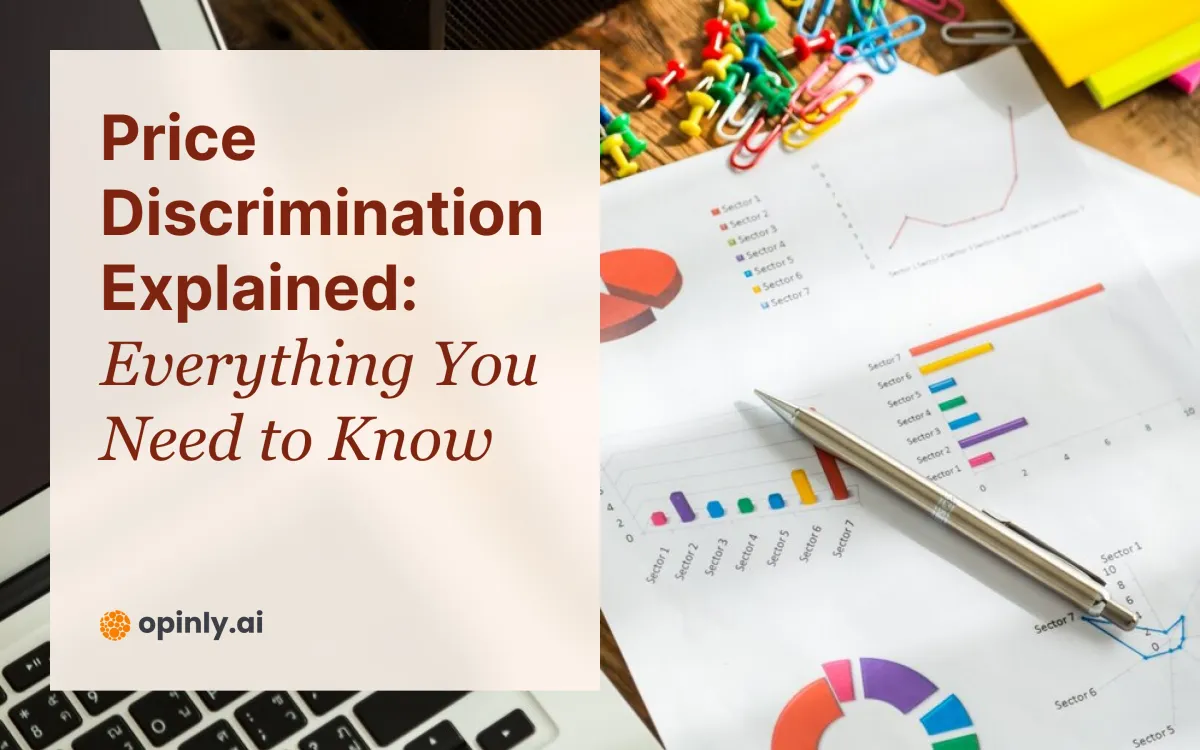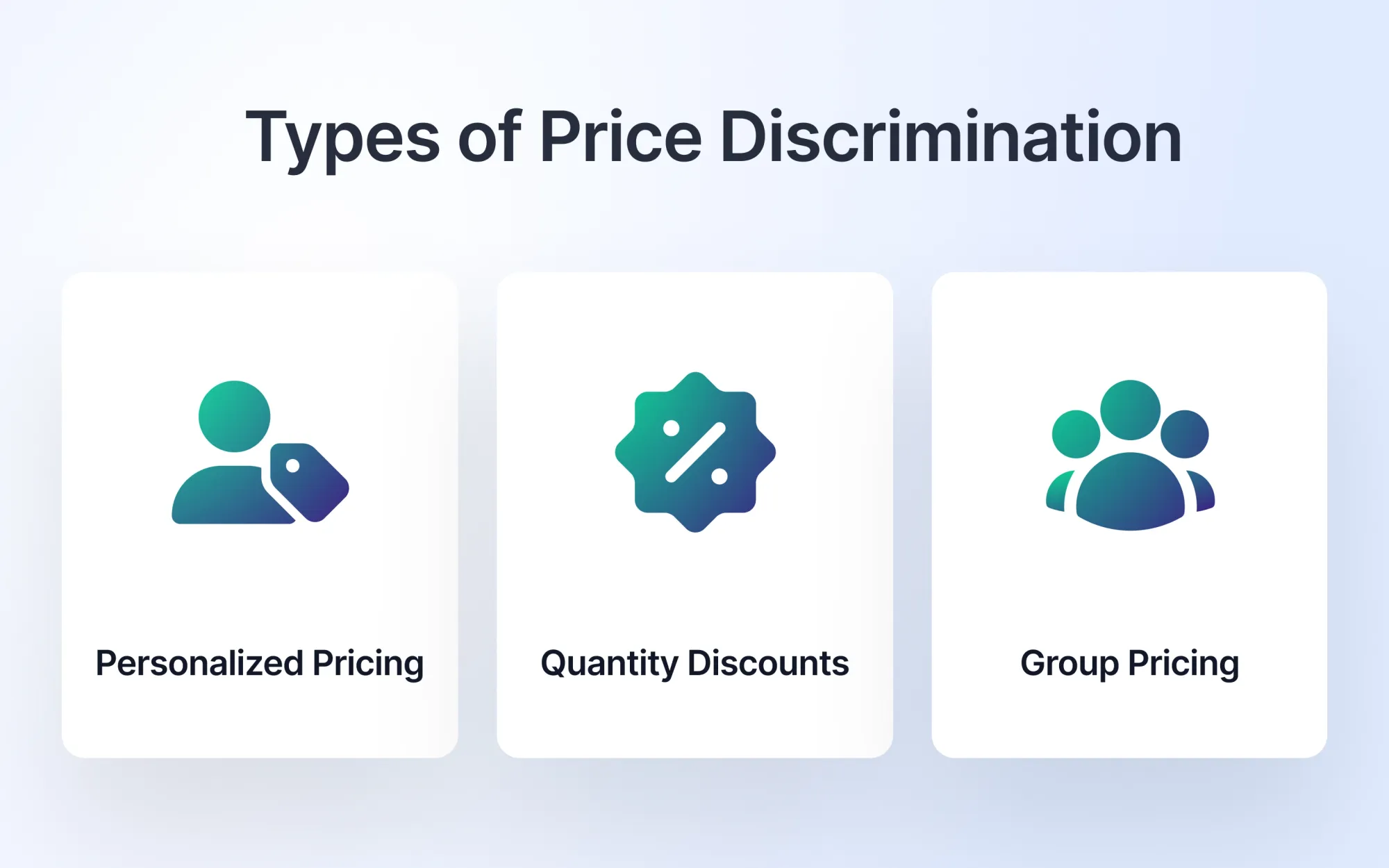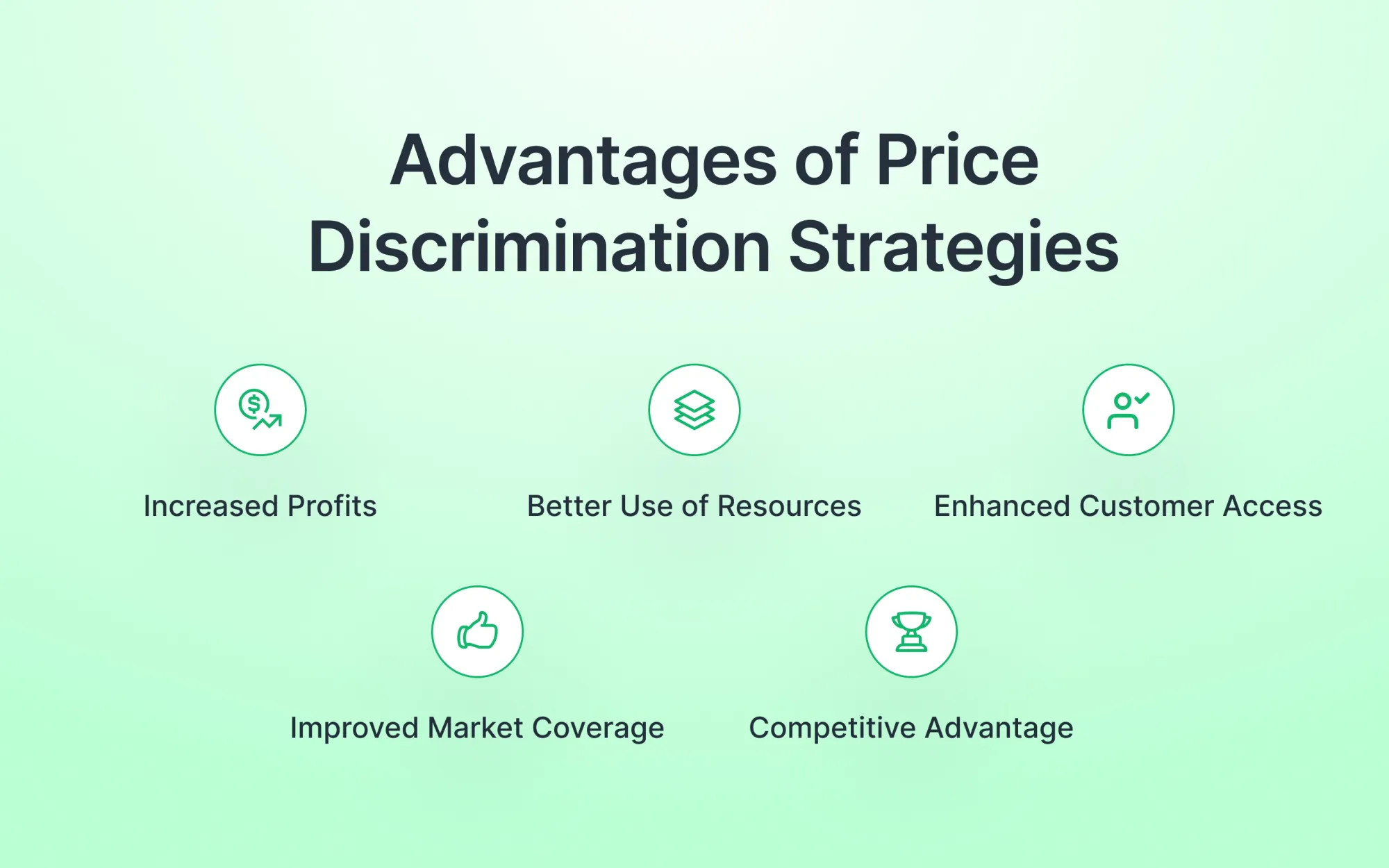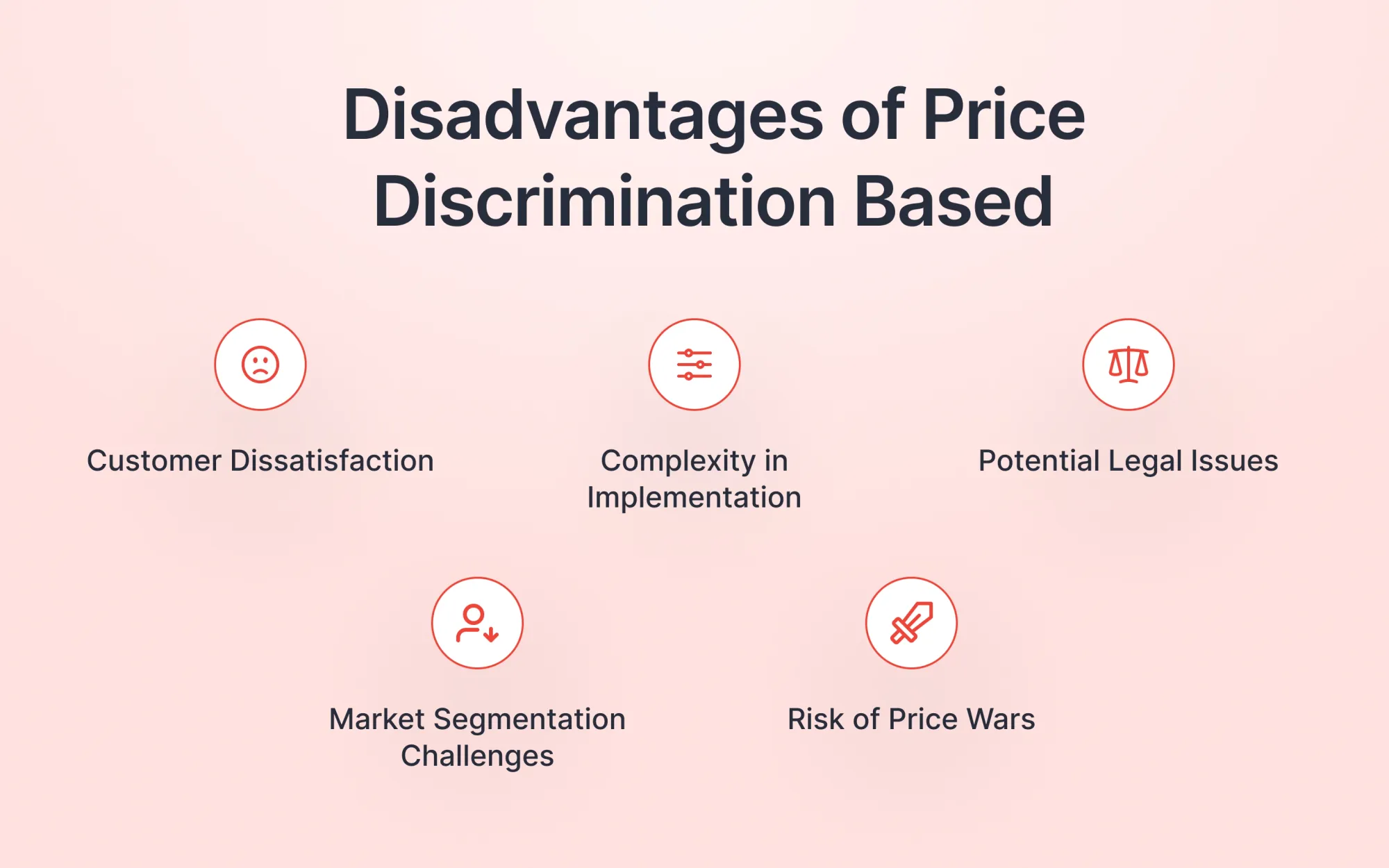Price Discrimination Explained: Everything You Need to Know
Learn all about price discrimination, how it works, and why businesses use it.

Have you ever wondered why the same product or service can have different prices for different people?
This is a common business practice known as price discrimination. In simple terms, price discrimination occurs when a company charges different prices to different customers for the same product or service.
The reasons behind this can vary, from maximizing profits to attracting different types of customers. In this article, we will break down what price discrimination is, how it works, and why it matters to both businesses and consumers.
Whether you're a curious consumer or a business owner looking to optimize your pricing strategy, this guide will provide you with everything you need to know about price discrimination.
Definition of Price Discrimination
Price discrimination is a strategy where a seller charges different prices to different customers for the same product or service. This is based on what the seller thinks each customer is willing to pay. In the most extreme form, each customer is charged the highest price they are willing to pay. More commonly, the seller divides customers into groups based on certain characteristics and charges each group a different price.
3 Different Types of Price Discrimination

1. First-Degree Price Discrimination (Personalized Pricing)
First-degree price discrimination, also known as personalized pricing, is when a seller charges each customer the highest price they are willing to pay for a product or service. Imagine you’re buying a car. Instead of having a fixed price, the dealer tries to figure out how much you personally are willing to spend.
They might ask questions about your budget, your needs, and how much you like the car. Based on this information, they decide on a price just for you. This means that two people buying the same car might end up paying different amounts based on how much each one is willing to pay. The goal for the seller is to get the most money possible from each customer by tailoring the price to fit each person's willingness to pay.
2. Second-Degree Price Discrimination (Quantity Discounts)
Second-degree price discrimination, commonly known as quantity discounts, is when the price of a product decreases as you buy more of it. Think of it like shopping at a warehouse store where you get better deals if you buy in larger quantities. For example, if you buy one can of soda, it might cost $1.00 each, but if you buy a pack of 12, each can might only cost $0.75.
This system encourages customers to buy more because they get a lower price per item when they purchase in bulk. Businesses use this strategy to increase sales volume, reduce inventory, and make customers feel like they are getting a good deal. So, the more you buy, the cheaper it gets per item, which can be a win-win for both the customer and the seller.
3. Third-Degree Price Discrimination (Group Pricing)
Third-degree price discrimination, also known as group pricing, is when businesses charge different prices to different groups of people based on certain characteristics like age, location, or occupation.
For example, think about a movie theater. They often have different ticket prices for various groups:
- Students: They might get a discount because they usually have less money to spend.
- Seniors: Older adults often pay less because they are on a fixed income.
- Children: Kids usually get cheaper tickets to encourage families to come.
- Regular Adults: They pay the standard price.
This approach helps businesses attract more customers by offering lower prices to groups who might not otherwise be able to afford the service. It also allows the business to maximize profits by charging a higher price to those who can pay more. So, depending on which group you belong to, you might pay a different price for the same product or service.
Requirements for an Effective Price Discrimination

For a company to use price discrimination effectively, certain conditions must be met:
1. Imperfect Competition
Imperfect competition means that the company has some control over the prices it sets for its products or services. This happens in markets where the company is not just one of many identical sellers, but has some unique advantages or a dominant position, giving it some monopoly power.
In a perfectly competitive analysis market, many sellers offer the same product, and no single company can influence the price. Everyone sells at the same price because if one company tries to charge more, customers will just buy from someone else.
However, in an imperfectly competitive market, the company can set its prices higher or lower without losing all its customers. This is because there are fewer competitors, or the company's product is unique in some way.
Example:
Imagine a popular smartphone brand like Apple. Apple has some control over its prices because its iPhones are unique and have a strong brand following. Even if Apple raises its prices a bit, many customers will still buy iPhones because they value the brand and the features it offers. This would not be possible in a market where many companies sell identical smartphones; in such a market, if one company raises its prices, customers would simply buy from another company offering a lower price.
So, because Apple operates in a market with imperfect competition, it can act as a price maker and use strategies like price discrimination to maximize profits.
2. Prevention of Resale
Prevention of resale means that a company must ensure that customers who buy a product or service at a lower price cannot turn around and sell it to others at a higher price. This is important because it helps the company maintain its pricing strategy without it being disrupted by resellers. If resale happens, the company loses control over its pricing and the ability to charge different prices to different customers.
Example:
Imagine a software company that sells its product to students at a discounted price of $50, while the regular price for other customers is $100. If students were allowed to resell the software to others, they could buy it for $50 and sell it to non-students for, say, $75. This would undermine the company's ability to charge $100 to non-students, as people would prefer buying the cheaper resale version.
To prevent this, the software company might implement measures like requiring a student ID for purchase, using unique license keys that can only be activated once, or restricting the transfer of licenses. By doing this, the company ensures that only eligible customers can buy at the discounted price and that the software can't be easily resold to others who would have paid more.
This way, the company can effectively use price monitoring discrimination, charging lower prices to students and higher prices to other customers, without the risk of its strategy being undermined by resale.
3. Different Elasticities of Demand
Elasticity of demand refers to how much the quantity of a product people want changes when its price changes. Different groups of customers respond differently to price changes, which is crucial for businesses to understand.
Price Sensitivity Varies Among Customer Groups
For example, consider airplane tickets.
- Low-Income Individuals: These customers are very sensitive to price changes. If the price of an airplane ticket goes up, they might choose not to fly or look for cheaper alternatives like buses or trains. This high sensitivity to price changes means their demand is highly elastic.
- Business Travelers: On the other hand, business travelers are usually less sensitive to price changes. They often need to travel regardless of the cost, as it is essential for their work. So, even if ticket prices increase, they will still buy them. This low sensitivity to price changes means their demand is inelastic.
Advantages of Price Discrimination Strategies

Price discrimination is when businesses charge different prices to different customers for the same product. Here are five simple advantages of this strategy:
1. Increased Profits:
When businesses charge higher prices to customers who are willing to pay more, they can earn more money. For instance, if a customer is ready to pay $100 for a product, selling it at that price instead of $80 increases the business's profit. This strategy helps companies make more money by adjusting prices based on what customers are willing to spend.
2. Better Use of Resources:
Businesses can sell more products by giving discounts to customers who are careful about spending money. This way, they can use their resources better because more products are sold, and fewer items go to waste. By lowering prices for these customers, businesses ensure that more of their products find buyers, leading to less unused stock and more efficient use of their resources.
3. Enhanced Customer Access:
When businesses lower their prices, more people can afford to buy their products. For example, if a company offers student discounts, students who couldn’t buy the product at full price can now afford it. This way, the product becomes accessible to a wider range of customers. By making prices more affordable, businesses can reach more people and increase their customer base.
4. Improved Market Coverage:
When businesses offer different prices for different types of customers, they can attract more people. For example, they might sell a luxury version of a product for high-income customers and a basic version for low-income customers. This way, they can reach both rich and budget-conscious customers. By having different options, businesses can cover more of the market and get more customers overall.
5. Competitive Advantage:
When businesses use different prices for different situations, they can handle changes in the market better. For example, during times when fewer people are buying, they can lower their prices to attract more customers. This helps them stay ahead of competitors who don't change their prices. By adjusting prices based on demand, these businesses can keep more customers and stay strong in the market.
In simple terms, price discrimination helps businesses make more money, use their resources better, make products accessible to more people, attract different types of customers, and stay competitive in the market.
Disadvantages of Price Discrimination Based

1. Customer Dissatisfaction:
When some customers discover they paid more for a product than others, they might feel it’s unfair. For instance, if someone pays $100 for an item but finds out another person got it for $80, they may feel upset. This sense of unfairness can make customers unhappy and harm the business's reputation. Unhappy customers might complain or choose not to buy from the business again, which can hurt the company's image and sales.
2. Complexity in Implementation:
Setting different prices for different types of customers can be quite complicated. It involves a lot of work, like doing detailed market research to understand what different customers are willing to pay. Businesses also need to come up with careful pricing plans and keep a close watch on how well these plans are working. This ongoing effort to manage and adjust prices can be difficult and time-consuming, making it a challenging strategy to use effectively.
3. Potential Legal Issues:
Using different prices for different customers can sometimes cause legal problems. If it seems unfair or discriminatory, people might take legal action against the business. This means companies have to be very careful to follow all the relevant laws and regulations when they set different prices. If they don’t, they could face lawsuits, fines, or other legal troubles. Ensuring everything is legal and fair can be a complex and risky part of using price discrimination.
4. Market Segmentation Challenges:
Figuring out how much different customers are willing to pay can be tricky. Businesses need to accurately identify and group customers based on their spending habits, but this is not always easy. If they get it wrong and misjudge these groups, they might end up losing sales or making less money. For example, if a business thinks a group of customers will pay more but they actually won't, the higher prices could drive those customers away. This makes it challenging to use price discrimination effectively.
5. Risk of Price Wars:
When a business sets different prices for different customers, competitors might react by lowering their prices. This can lead to a situation called a price war, where businesses keep cutting prices to attract customers. Price wars can reduce the amount of money each business makes on each sale. As prices keep dropping, all the businesses involved might find it hard to make a good profit, making the market less profitable for everyone.
What Best Describes Price Discrimination?

Price discrimination is a pricing strategy where a business charges different prices for the same product or service to different customers, based on various factors. This approach is used to maximize profits by capturing the maximum willingness to pay from different segments of the market. The key elements that best describe price discrimination include:
1. Different Prices for Different Customers:
Businesses charge different prices for the same product or service depending on the customer's characteristics, such as their willingness to pay, purchasing power, or demographic factors like age and location. For example, a movie theater might charge lower ticket prices for seniors and students compared to regular adults.
2. Market Segmentation:
To effectively implement price discrimination, businesses need to divide their market into distinct segments. These segments can be based on various criteria, such as income level, buying behavior, or geographic location. The aim is to tailor prices to each segment's specific needs and price sensitivity.
3. Maximizing Revenue:
The primary goal of price discrimination is to increase overall revenue by capturing consumer surplus—the difference between what customers are willing to pay and what they actually pay. By adjusting prices, businesses can extract more value from customers who are willing to pay more, while still attracting price-sensitive customers with lower prices.
Conclusion
Price discrimination is a strategy where businesses charge different prices to different customers for the same product or service. This helps them make more money by getting each customer to pay the most they are willing to. By understanding and dividing their market into groups, businesses can set prices that match what each group is willing to pay. However, this strategy can be complicated to manage and must be done carefully to avoid legal and ethical problems. Overall, price discrimination can be very effective if done correctly, helping businesses increase their profits while serving a wide range of customers.
Frequently Asked Questions
1. What do you mean by price discrimination?
Price discrimination means charging different prices to different customers for the same product or service. This helps businesses maximize their profits by getting each customer to pay what they're willing to.
2. What is perfect price discrimination?
Perfect price discrimination is when a business charges each customer the maximum price they are willing to pay. This is very rare in real life because it requires knowing exactly what each customer is willing to spend.
3. What is the idea behind price discrimination?
The idea behind price discrimination is to increase profits by adjusting prices based on what different customers are willing to pay. It helps businesses capture more revenue from customers who value the product more, while still attracting those who are more price-sensitive.
4. What is another word for price discrimination?
Another word for price discrimination is price differentiation.
5. What are the conditions of price discrimination?
Conditions of price discrimination include having different customer groups with varying willingness to pay, being able to segment and identify these groups, having the capability to enforce different prices without arbitrage (buying low and selling high between different customer groups), and possessing market power to effectively control prices across different segments.
